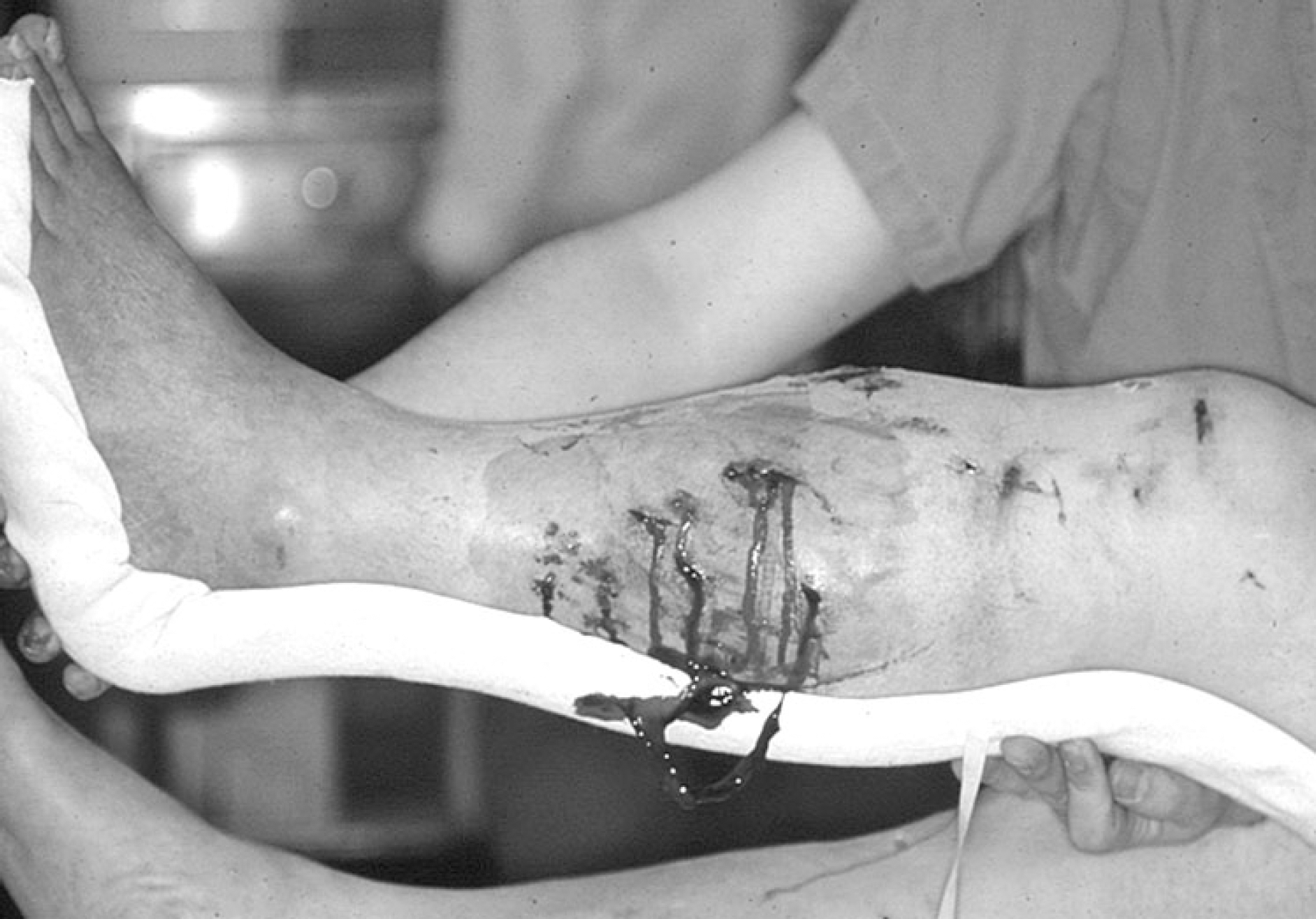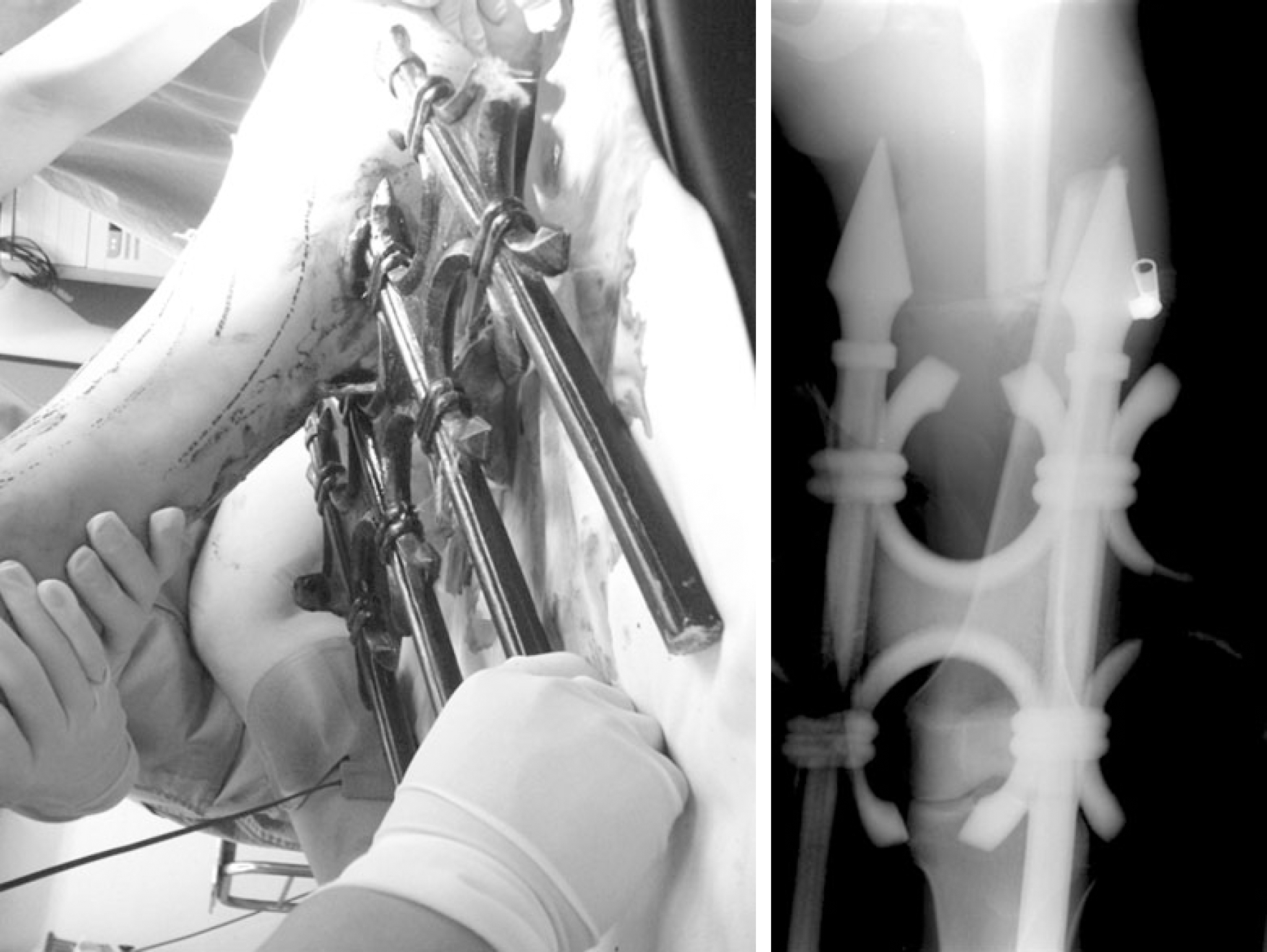References
1). The Korean Fracture Society: Principles of fracture management. 1st ed.Seoul;Pan Mun Education: 2013.
2). Oh HK. General assessment and initial management of polytrauma patients. J Korean Fract Soc. 26:230–240. 2013.

3). Crist BD, Ferguson T, Murtha YM, Lee MA. Surgical timing of treating injured extremities: an evolving concept of urgency. Instr Course Lect. 62:17–28. 2013.
4). McQueen MM, Christie J, Court-Brown CM. Acute compartment syndrome in tibial diaphyseal fractures. J Bone Joint Surg Br. 78:95–98. 1996.

5). Matava MJ, Whitesides TE Jr, Seiler JG 3rd, Hewan-Lowe K, Hutton WC. Determination of the compartment pressure threshold of muscle ischemia in a canine model. J Trauma. 37:50–58. 1994.

6). Lee KB, Lee SH. Diagnosis and management of acute compartment syndrome. J Korean Fract Soc. 28:93–101. 2015.

7). McQueen MM, Court-Brown CM. Compartment monitoring in tibial fractures. The pressure threshold for decompression. J Bone Joint Surg Br. 78:99–104. 1996.
8). Finkelstein JA, Hunter GA, Hu RW. Lower limb compartment syndrome: course after delayed fasciotomy. J Trauma. 40:342–344. 1996.
9). Mills WJ, Barei DP, McNair P. The value of the ankle-brachial index for diagnosing arterial injury after knee dislocation: a prospective study. J Trauma. 56:1261–1265. 2004.

10). Bynoe RP, Miles WS, Bell RM, et al. Noninvasive diagnosis of vascular trauma by duplex ultrasonography. J Vasc Surg. 14:346–352. 1991.

11). Rieger M, Mallouhi A, Tauscher T, Lutz M, Jaschke WR. Traumatic arterial injuries of the extremities: initial evaluation with MDCT angiography. AJR Am J Roentgenol. 186:656–664. 2006.

12). Hafez HM, Woolgar J, Robbs JV. Lower extremity arterial injury: results of 550 cases and review of risk factors associated with limb loss. J Vasc Surg. 33:1212–1219. 2001.

13). Barei DP, Nork SE, Mills WJ, Henley MB, Benirschke SK. Complications associated with internal fixation of high-energy bicondylar tibial plateau fractures utilizing a two-incision technique. J Orthop Trauma. 18:649–657. 2004.

14). Rihn JA, Groff YJ, Harner CD, Cha PS. The acutely dislocated knee: evaluation and management. J Am Acad Orthop Surg. 12:334–346. 2004.

15). Robson MC, Duke WF, Krizek TJ. Rapid bacterial screening in the treatment of civilian wounds. J Surg Res. 14:426–430. 1973.

16). Gristina AG, Costerton JW. Bacterial adherence to biomaterials and tissue. The significance of its role in clinical sepsis. J Bone Joint Surg Am. 67:264–273. 1985.

17). Gristina AG, Naylor PT, Webb LX. Molecular mechanisms in musculoskeletal sepsis: the race for the surface. Instr Course Lect. 39:471–482. 1990.
18). Gristina AG, Oga M, Webb LX, Hobgood CD. Adherent bacterial colonization in the pathogenesis of osteomyelitis. Science. 228:990–993. 1985.

19). Gristina AG, Naylor PT, Myrvik QN. Mechanisms of musculoskeletal sepsis. Orthop Clin North Am. 22:363–371. 1991.

20). Werner CM, Pierpont Y, Pollak AN. The urgency of surgical débridement in the management of open fractures. J Am Acad Orthop Surg. 16:369–375. 2008.

21). Swiontkowski MF, Winquist RA, Hansen ST Jr. Fractures of the femoral neck in patients between the ages of twelve and forty-nine years. J Bone Joint Surg Am. 66:837–846. 1984.

22). Protzman RR, Burkhalter WE. Femoral-neck fractures in young adults. J Bone Joint Surg Am. 58:689–695. 1976.

23). Haidukewych GJ, Rothwell WS, Jacofsky DJ, Torchia ME, Berry DJ. Operative treatment of femoral neck fractures in patients between the ages of fifteen and fifty years. J Bone Joint Surg Am. 86:1711–1716. 2004.

24). Jain R, Koo M, Kreder HJ, Schemitsch EH, Davey JR, Mahomed NN. Comparison of early and delayed fixation of subcapital hip fractures in patients sixty years of age or less. J Bone Joint Surg Am. 84:1605–1612. 2002.

25). Gautier E, Ganz K, Krügel N, Gill T, Ganz R. Anatomy of the medial femoral circumflex artery and its surgical implications. J Bone Joint Surg Br. 82:679–683. 2000.

26). Sevitt S, Thompson RG. The distribution and anastomoses of arteries supplying the head and neck of the femur. J Bone Joint Surg Br. 47:560–573. 1965.

27). Upadhyay A, Jain P, Mishra P, Maini L, Gautum VK, Dhaon BK. Delayed internal fixation of fractures of the neck of the femur in young adults. A prospective, randomised study comparing closed and open reduction. J Bone Joint Surg Br. 86:1035–1040. 2004.
28). Liporace F, Gaines R, Collinge C, Haidukewych GJ. Results of internal fixation of Pauwels type-3 vertical femoral neck fractures. J Bone Joint Surg Am. 90:1654–1659. 2008.

29). Tooke SM, Favero KJ. Femoral neck fractures in skeletally mature patients, fifty years old or less. J Bone Joint Surg Am. 67:1255–1260. 1985.

30). Bray TJ. Femoral neck fracture fixation. Clinical decision making. Clin Orthop Relat Res. 339:20–31. 1997.
31). Scheck M. Intracapsular fractures of the femoral neck. Comminution of the posterior neck cortex as a cause of unstable fixation. J Bone Joint Surg Am. 41:1187–1200. 1959.
32). Song HK, Lee JJ, Oh HC, Yang KH. Clinical implication of subgrouping in valgus femoral neck fractures: comparison of 31-B1.1 with 31-B1.2 fractures using the OTA/AO classification. J Orthop Trauma. 27:677–682. 2013.
34). Canale ST, Kelly FB Jr. Fractures of the neck of the talus. Long-term evaluation of seventy-one cases. J Bone Joint Surg Am. 60:143–156. 1978.
Go to : 
 | Fig. 1.Acute compartment syndrome in lower extremity with open fracture. We can observe the venous congestion around the foot. |
 | Fig. 2.An example of an open fracture because of fall. The patient needs early debridement and fixation. A case of open femur fracture due to fall from the roof. |
 | Fig. 3.Regional x-rays of a polytrauma patient. We can observe severe comminuted fracture of femur diaphysis and elbow. The acetabular fracture and flail chest can also be seen. |
Table 1.
The Abbreviated Injury Scale (AIS) and an Example of Scoring Each Element according to Injury




 PDF
PDF ePub
ePub Citation
Citation Print
Print


 XML Download
XML Download